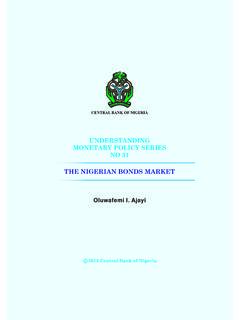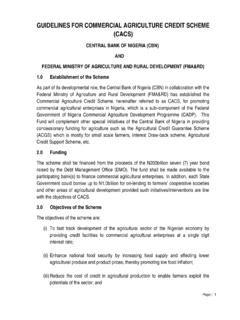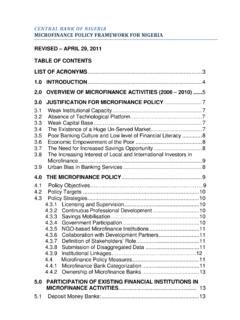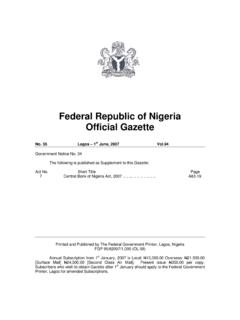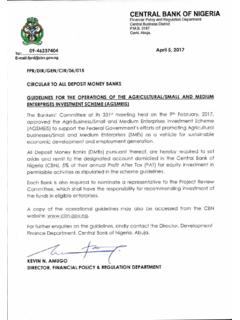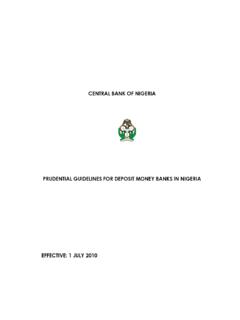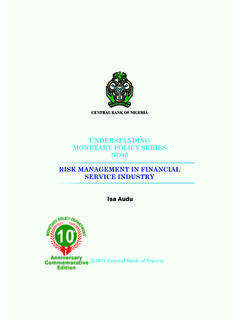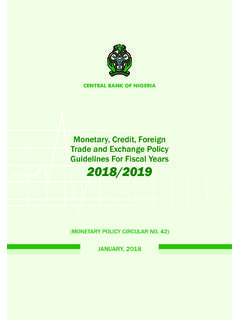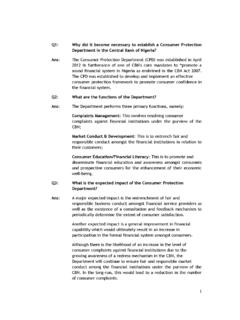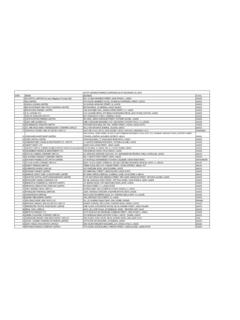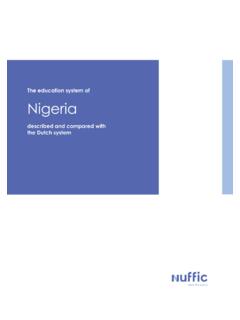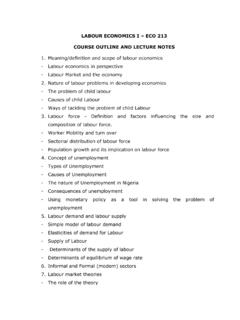Transcription of Financial System Strategy 2020 - Central Bank of Nigeria
1 Banji Oyelaran-OyeyinkaSMEs1 Financial System Strategy2020 FSS 2020 International ConferenceSME: Issues, Challenges and ProspectsBy Prof. Banji Oyelaran-OyeyinkaDirector Monitoring &Research Division (UN-HABITAT)Visiting Professor, Innovation, Technology & Development, The Open University, Banji Oyelaran-OyeyinkaSMEs2 FSS 2020 Introduction SMEs are a very important part of the nigerian economy. In countries at same levels of development with Nigeria , SMEs contribute a much higher proportion to GDP than currently observed in Nigeria Compared to other emerging markets, Nigeria has historically shown lack of commitment to building a strong SME sector; These economies have shown consistent commitment to the development of SMEs by implementing.
2 Access to finance and Financial incentives, basic and technological infrastructure, adequate legal and regulatory framework, and a commitment to building domestic expertise and knowledge In light of recent events in the nigerian macroeconomic environment, SMEs have compelling growth potential and like other emerging economies are likely to constitute a significant portion of GDP in the near future In this presentation, we will take a look at SMEs in Nigeria , some of the current challenges being faced and present a case for progress for SMEs in NigeriaBanji Oyelaran-OyeyinkaSMEs3 FSS 2020 SMEs in Nigeria SMEs are broadly defined(1)as businesses with turnover of less than N100 MM per annum and/ or less than 300 employees Studies by the IFC show that approx.
3 96% of nigerian businesses are SMEscompared to 53% in the US and 65% in Europe SMEs represent about 90% of the manufacturing/ industrial sector in terms of number of enterprises, They contribute approx. 1% of GDP compared to 40% in Asian countries and 50% in the US or Europe In Nigeria , SMEs are distributed by clusters within regions 1 Definition sums up several nigerian institution definitions of SMEs, Central Bank, Fed. Ministry of Industry, NASMEB anji Oyelaran-OyeyinkaSMEs4 FSS 2020 SME Contribution Manufactured Exports by SMEs16 <100 employees Early 1990s Singapore <Rs 30 M investment in plant & machinery 1991/1992 India 20 <200 employees Early 1990s Vietnam <300 employees 1995 Korea 40-60 <100 employees Early 1990s China 56 <100 employees Early 1990s Chinese Taipei Developing Economies % SME manufacture exports Definition of an SME (a)
4 Year Economy Banji Oyelaran-OyeyinkaSMEs5 FSS 2020 Selected Regional & Sectoral Distribution of SME ClustersKATSINAKATSINASOKOTOSOKOTOGUSAUZ AMFARAKEBBIBIRNNKEBBINIGERKADUNAKADUNAMI NNIAKONTANGORABORNUJALINGOYOBEJIGAWAKANO GOMBEBAUCHIADAMAWATARABAYOLAGOMBEBAUCHIK ANODUTSEDAMATURUMAIDUGURIPLATEAUJOSBENUE MAKURDINASSARAWAL afiaLOKOJAKOGIFCTCROSSRIVERSCALABARAKWAI BOMRIVERSUYOPORTHARCOURTABIAIMOENUGUEBON YIANAMBRADELTABAYELSAYENAGOAASABAENUGUAB AKALIKILAGOSIKEJAKWARAILORINOYOOGUNEKITI OSUNONDOEDOOFFAIBADANABEOKUTAADO EKITIBENIN CITYOSHOGBOAKUREKano Leather SME ClustersAbeokuta Tie & Dye SME ClustersNnewi Automotive SME ClustersOshogbo Tie & Dye SME ClustersLagos Otigba ICT SME ClustersAba Leather, Feather & Fashion SME ClustersBanji Oyelaran-OyeyinkaSMEs6 FSS 2020 Opportunities outweigh Challenges50 99employees>100employees10 = 49employees SMEs have significant untapped growth potential Strong export and employment potentials SMEs in Nigeria are currently distributed along sectors within regions; creating potential operational and cost synergies New growing sectors, such as entertainment and leisure clusters Low=Tech Sectors clusters: Footwear, clothing & garment, agro=processing (cassava, oil palm and other oils.)
5 High Tech clusters: ICTs, Telecom, and Biotechnology (agric and health) OpportunitiesChallenges Huge gaps in infrastructure Poor Financial support and credit environment High levels of unskilled workforce Low investment commitment to bring pilot plants to commercial scaleBanji Oyelaran-OyeyinkaSMEs7 FSS 2020 Where we Are: Financial Africa EurozoneTotal Loans as % of GDP (BMI, 2006) SMEs require improved Financial support Studies show that Nigeria has a low amount of domestic investment through loans vis= =vis other emerging markets Majority of the loans granted are issued to large corporates and governments Mostly Informal financingLagos NnewiSources of FundingPrivate BanksDevelopment BanksGovt.
6 CreditFriendsPersonal50%31%29%21%18%76%3 8%0%29%19%ResultNANAWeakWeakWeak2005 Survey: Lagos ICT & Nnewi Auto ClustersBanji Oyelaran-OyeyinkaSMEs8 FSS we Are: Knowledge InputR&D as % of GDP It is a lack of investment in human capital, not a lack of investment in physical capital alone, which prevents poor countries from catching up with rich ones. Educational attainment and public spending on education are correlated positively to economic growth Benhabib and Spiegel, 1994 Import of physical capital is less costly than the domestic development of human capital and technical expertiseLagos NnewiHuman Capital SupportSecondary EducationTertiary EducationR&DTrainingSkilled ManpowerWeakWeakWeakWeak20 WeakWeakWeakWeakxxResultWeakWeakWeakWeak 4152005 Survey: Lagos ICT & Nnewi Auto Clusters751xxxx154# UniversitiesPopulation (MM)(1)1 2007 IMF estimates WeakWeakWeakBanji Oyelaran-OyeyinkaSMEs9 FSS 2020020040060080001,0002,0003,0004,0005, 000 Where we Are : Infrastructural InputGDP/Capita ($) vs.
7 Internet Users (2000) Given adequate levels of investment in human capital, strong correlations exist between the rapid rates of industrialisation over the long term and the investments in physical capital Sanberg, 1962(1) Majority of private sector led initiatives outperform public sector led onesLagos NnewiInfrastructureInternetTelephoneTran sportWaterPoorFairGoodGoodPoorPoorGoodGo odResultPoorPoorGoodGoodElectricityPoorP oorPoor2005 Survey: Lagos ICT & Nnewi Auto Clusters1 ParaphrasedMauritiusSouth AfricaBotswanaGabonNigeriaBanji Oyelaran-OyeyinkaSMEs10 FSS 2020 Ratings of InfrastructureRatings by Otigba SMEs020406080100120 InternetTelephoneRoadsWaterElectricityAs sessment of Physical Infrastructure ProvisionBadFairGoodBanji Oyelaran-OyeyinkaSMEs11 FSS 2020 Where we Are : Government InputLagos NnewiSupport SystemsGovt.
8 IncentivesInnovationIT SupportIntellectual PropertyWeakFairWeakWeakWeakWeakWeakWeak ResultWeakWeakWeakWeakVenture CapitalWeakWeakWeak2005 Survey: Lagos ICT & Nnewi Auto ClustersRanking(1)of Countries by Overall Govt. Support1 Ranking index is based on overall Govt support through: Financing, Infrastructure, Knowledge, AfricaMalaysiaBrazilIndiaUSA Vital role of Government in providing an enabling environment for SMEs can t be overemphasized The more successful emerging markets have high rankings as a result of government support in enabling the private sector , and SMEs specifically SMEs surveys show weak overall support from GovernmentBanji Oyelaran-OyeyinkaSMEs12 FSS 2020 SMEs Severely Constrained Need for Policy CustomformalFinance Info onsource ImportDutiesMultiplicityof TaxesHigh RentSecurity ofLives Constraints Faced By Nnewi SMEsCluster Banji Oyelaran-OyeyinkaSMEs13 FSS 2020 Need for Policy Support SMEs tariffCustomformalitiesFinanceInfo onsoursecImportdutiesMultiplicityof taxesHigh rent security ofpropertiesSecurityof livesConstraints Faced by SMEs Firms in Aba Shoe Cluster Banji Oyelaran-OyeyinkaSMEs14 FSS 2020 Where we Are.
9 Manufacturing/ Industrial Output01020304060's70's80's90's2000'sKor eaTaiwanSingaporeManufacturing as % of GDPN igerian levels: 3 7% Manufacturing as % GDP in Nigeria has averaged 3 7% over the last few decades Fierce competition for the nigerian manufacturing sector come predominantly from Asia Manufacturing amongst Asian competitors account for 30=40% of GDP today SMEs today account for approx. 1% of total GDP and approx. 14% of total manufacturing contribution to GDP Studies show that <20% of SME manufacturers export Majority of exporters are experiencing decreasing levels of exporting due to competitive pressures from Asian counterparts0102030405060's70's80's90's2 000'sKoreaTaiwanSingaporeIndustries as % of GDPN igerian levels: 3 7%Banji Oyelaran-OyeyinkaSMEs15 FSS 2020 Where We Are In the private sector, there is a two-stage lag behind these other countries in developing capabilities for competitiveness.
10 Knowledge-resource accumulation is lagging 15 -30 years behind depending on which country; There is the more obvious 20-25-year lag in general economic development. Banji Oyelaran-OyeyinkaSMEs16 FSS 2020 The Asian severeWeak severeFairly severeSevereVery severeEffect of Asian Challenge on Otigba ClusterBanji Oyelaran-OyeyinkaSMEs17 FSS 2020 The Asian ChalengePerception of SMEsPerceptions of Market Access Strategies (%) Introduction of new Reliability in Price (lower) Quality (high) Design (superior) Strategy of Enterprises in OtigbaAsia's ChallengeBanji Oyelaran-OyeyinkaSMEs18 FSS 2020 Ranking on Innovation CIBanji Oyelaran-OyeyinkaSMEs19 FSS 2020 Where We Are on CICompetitiveness ratingPlot 2 ArgentinaAustraliaAustriaAzerbaijanBangl adeshBelarusBelgiumBeninBrazilBulgariaCa nadaChileChinaColombiaCongo, RicaCroatiaCzech RepublicDenmarkEcuadorEgypt, Arab Kong, ChinaHungaryIndiaIndonesiaIrelandIsraelI talyJamaicaJapanJordanKazakhstanKorea.
